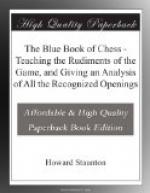{PGN 27}
[Event “?”] [Site “?”] [Date “1858.??.??”] [Round “?”] [White “Philadelphia”] [Black “New York”] [Result “1-0”] [ECO “C54”] [Annotator “The Blue Book of Chess, Game I., p. 108.”] [Mode “TC”] [PlyCount “77”]
1. e4 e5 2. Nf3 Nc6 3. d4 exd4 4. Bc4 Bc5 5. c3 Nf6 {The best move.} 6. e5 d5 7. Bb5 Ne4 8. cxd4 Bb6 9. Nbd2 {Preparatory to the move of Qc2.} O-O 10. Bxc6 bxc6 11. Qc2 {Threatening to win pawn at c6 or Nxe4, winning the d5 pawn.} Nxd2 12. Bxd2 Bg4 {If Black had played Ba6, to prevent White O-O, White would have won a piece by a4.} 13. Ng5 {A premature move.} g6 14. Qc3 f6 {The best move.} 15. h3 Bf5 {Better than fxg5, as White would then have opened the Rook’s file.} 16. Nf3 Be4 {Better than fxe5.} 17. Bf4 {The best move.} fxe5 18. Bxe5 Qe7 {Intending to advance c6 Pawn. A strong move.} 19. O-O-O {An impudent move, in the face of such an attack.} c5 20. Rhe1 {A strong move.} cxd4 {c4 perhaps stronger.} 21. Bxd4 c5 22. Be5 Rae8 {Weak. We cannot see its object. Why not Rad8?} 23. Bg3 Qb7 {The best move.} 24. Ne5 {Preparatory to Ng4, and then Be5.} d4 25. Qc4+ Bd5 26. Qa4 {Preventing Black’s contemplated move with the Q.} Re6 {With a view of withdrawing the B. and playing the Ra6.} 27. Ng4 h5 28. Rxe6 Bxe6 29. Qc2 Kh7 30. Re1 {The first move of a combination, which gave the victory to Philadelphia.} Bf5 {Insures the winning of the Kt.} 31. Qd2 {A powerful move, as it compels Black to take the Kt., and thereby opens White’s R’s file.} hxg4 32. hxg4 Qd5 {If Bxg4, White would have played Qg5, threatening to check K. and Q. with R., or win the R.} 33. Rh1+ ({An all important check before gxf5, as it prevented} 33. gxf5 Rxf5 34. Rh1+ Rh5) 33... Kg8 34. gxf5 Qxf5 35. Qh6 g5 36. Bd6 {A very attacking move. Much better than Be5.} Rf6 37. Qh5 {A better move than checking, as it prevented Black’s K. escaping to f7, and then to e6. White also threatened g4.} Qg6 ({Black would have lost the Rook, if} 37... Rxd6 38. Qe8+ Kg7 39. Qe7+) 38. Qh8+ Kf7 39. Re1 {The coup de grace.} 1-0
{PGN 28}
[Event “?”] [Site “?”] [Date “1857.??.??”] [Round “?”] [White “Philadelphia”] [Black “New York”] [Result “1-0”] [ECO “C44”] [Annotator “The Blue Book of Chess, Game II., p. 109.”] [Mode “PM”] [PlyCount “63”]




